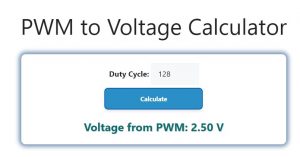About PWM to Voltage Calculator (Formula)
The PWM to Voltage Calculator is an essential tool for engineers, hobbyists, and anyone working with electronic circuits that use Pulse Width Modulation (PWM) signals. PWM is a technique used to control the amount of power delivered to electronic devices by varying the width of the pulses in a signal. This calculator allows users to easily convert PWM values to corresponding voltage levels, facilitating the design and troubleshooting of circuits. Whether you are working with microcontrollers, motor controllers, or LED dimmers, understanding the relationship between PWM and voltage is crucial for achieving desired outcomes.
Formula
The formula to convert PWM to voltage is: V = D / 256 * 5, where V represents the output voltage in volts, D is the PWM duty cycle value (0 to 255), and 5 is the reference voltage.
How to Use
Using the PWM to Voltage Calculator is straightforward. Follow these steps:
- Determine the Duty Cycle (D): Identify the PWM duty cycle value, which ranges from 0 (0% duty cycle) to 255 (100% duty cycle).
- Input the Value: Enter the duty cycle value into the calculator.
- Calculate Voltage (V): The calculator will compute the corresponding output voltage based on your input.
Example
Let’s consider an example where the PWM duty cycle is set to 128.
- Duty Cycle (D): 128
Using the formula:
V = D / 256 * 5
Calculating gives:
V = 128 / 256 * 5
V = 0.5 * 5
V = 2.5 V
Thus, the output voltage corresponding to a PWM duty cycle of 128 is 2.5 volts.

FAQs
- What is PWM? PWM stands for Pulse Width Modulation, a technique used to control the power delivered to devices by varying the width of the pulses in a signal.
- Why do I need to convert PWM to voltage? Converting PWM to voltage is essential for understanding the actual voltage levels being applied to components in your circuit.
- What is the range of the PWM duty cycle? The PWM duty cycle typically ranges from 0 (0% duty cycle) to 255 (100% duty cycle).
- What does a 100% duty cycle mean? A 100% duty cycle means the signal is constantly high, providing the maximum voltage output.
- Can this calculator be used for different reference voltages? The formula provided uses a 5V reference; if your circuit operates at a different voltage, adjust the formula accordingly.
- How does changing the duty cycle affect voltage? Increasing the duty cycle increases the average output voltage, while decreasing it lowers the voltage.
- What components can I control using PWM? PWM is commonly used to control motors, LEDs, and other electronic devices that require variable power.
- What happens if I enter a duty cycle value greater than 255? Values greater than 255 are outside the standard PWM range and will yield incorrect voltage calculations.
- Is PWM voltage linear? Yes, the relationship between duty cycle and voltage output is linear, meaning doubling the duty cycle will double the output voltage.
- How can I measure the output voltage from a PWM signal? Use a multimeter to measure the average voltage output from the PWM signal at the load.
- Can I use this calculator for both digital and analog applications? Yes, the PWM to Voltage Calculator is applicable for both digital circuits and any analog devices that interpret PWM signals.
- What is the significance of the 256 value in the formula? The value 256 represents the total possible steps in an 8-bit PWM signal (0 to 255).
- What is a typical application of PWM? Common applications include motor speed control, LED brightness control, and signal modulation.
- Can this calculator assist with microcontroller programming? Yes, understanding PWM to voltage conversions is vital when programming microcontrollers for various tasks.
- How do temperature changes affect PWM-controlled devices? Temperature can affect the performance of electronic components; monitoring the PWM output can help mitigate potential issues.
- What should I consider when using PWM for high-power devices? Ensure that the PWM frequency and duty cycle are suitable for the load to prevent overheating and damage.
- Can I simulate PWM outputs with this calculator? While this calculator provides voltage outputs, simulations may require additional software or tools.
- Is the output voltage instantaneous or averaged? The voltage calculated is an average value of the PWM signal over time.
- What type of filter can I use to smooth PWM signals? Low-pass filters are commonly used to smooth PWM signals into a more constant voltage output.
- Are there safety concerns when using PWM? Always ensure that the PWM duty cycles and voltages are within the rated limits of your components to avoid damage or hazards.
Conclusion
The PWM to Voltage Calculator is a vital tool for anyone working with electronic circuits that utilize Pulse Width Modulation. By providing a simple method to convert PWM duty cycles to corresponding voltage levels, this calculator enhances understanding and facilitates the design and troubleshooting of electronic systems. Whether you’re a hobbyist, engineer, or student, mastering the relationship between PWM and voltage is crucial for successfully implementing and optimizing your projects. With this calculator, you can ensure accurate voltage levels, enhancing the performance and reliability of your electronic applications.
